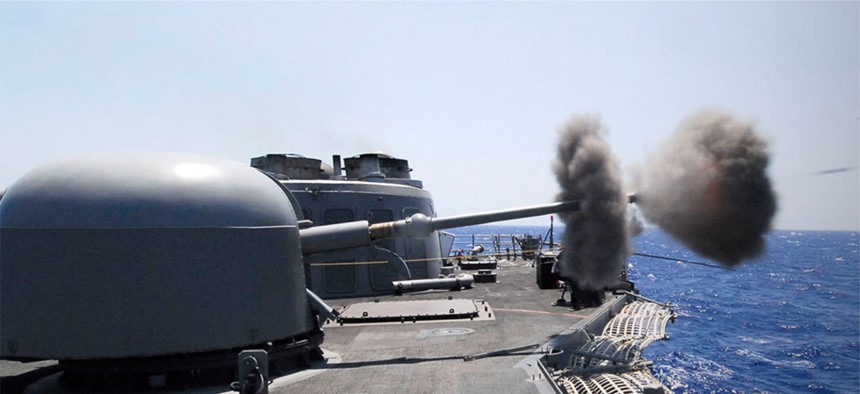A Gunfight Breaks Out Over Navy Ship’s Cannon
A fight has erupted between gunmakers vying to arm the Littoral Combat Ship from swarm boats
A good old-fashioned gunfight involving a controversial Navy ship has sparked a debate about whether bigger is actually better. Like many things, it depends on who you ask.
Criticism about the Littoral Combat Ship’s ability to survive in battle prompted the Navy to eye a series of firepower-boosting upgrades and to redesignate the ship a frigate. Service officials have not finalized the ship’s configuration; meanwhile, companies and experts are weighing in on the best mix of weapons for it.
Currently, both versions of LCS, the Lockheed Martin-made Freedom class and the Austal-made Independence class, carry a BAE Systems Mark 110 57-millimeter gun. The bow-mounted gun is the ship’s main defense against fast-moving and swarming boats.
But rival firm DRS Technologies says its OTO Melara 76-millimeter gun is more powerful and can fire smart rounds at longer ranges, meaning it could strike sooner than the BAE weapon.
“You don’t want to be outgunned,” said Eric Lindenbaum, vice president of Navy and Maritime programs for DRS Technologies, hefting a dummy 76-millimeter round. “The 76 is bigger [and] goes farther. I can hit further away from you and I can hit you and you can’t hit me.”
Lindenbaum spoke last month at the Navy League’s Sea-Air-Space conference just outside of Washington. His top talking point: 55 countries, including Iran, use 76-millimeter guns on their naval ships, meaning the it would be out-gunned at sea. The U.S. used the OTO Melara on its Perry-class frigate, the last of which was retired last year. The Coast Guard uses a 76-millimeter gun on its Medium Endurance Cutters.
As well, larger, 76-millimeter rounds can be packed with electronics, allowing the bullets to behave more like a missiles, Lindenbaum said. Behind him, a screen showed video from tests of the gun and its high-tech ammo with different types of fuzes and guidance systems.
“This isn’t a PowerPoint presentation,” he said. “This is actually out there shooting at a moving drone target coming in and blowing it out of the sky.”
DRS executives say their larger gun could even replace the missiles that the Navy plans to add to the LCS to hit targets beyond the horizon.
But bigger is not always better. The Navy planned to put a 57-millimeter gun on its new DDG 1000 destroyer, but after tests, chose a 30-millimeter gun instead, Defense News’ Christopher Cavas reported in 2014.
Elsewhere on the Sea-Air-Space display floor, BAE Systems executives called their 57-millimeter gun more accurate than larger weapons.
“You’re only going to be as accurate as you point the gun,” said Tom Pfenning, who oversees business development for BAE’s Weapons Systems team.
Pfenning said the 57-millimeter gun turret’s smaller size and lighter weight was better fitted for the LCS. The ammunition weighs less as well.
And BAE says it will have its own smart 57mm round as well. Now under development, the Ordnance for Rapid Kill of Attack Craft or ORKA (pronounced like the whale) is programmable so it can find certain types of targets, such as a small boat or personal watercraft, and distinguish them among clutter.
“What this does is it really ensures that you get one shot [that] amounts to one kill to the maximum range,” Pfenning said.
Meanwhile, Congress is pushing the Navy’s development of the Advanced Low Cost Munitions Ordnance, or ALaMO, a 57-millimeter round. But both BAE and DRS say their smart rounds are far more sophisticated because they can maneuver throughout flight, continuously correcting their path to a target.
In recent years, there has been intense debate in Congress and on Capitol Hill about how the Littoral Combat Ship would fare in battle. It was designed to operate near the coast at high speeds. Missions include mine countermeasures, antisubmarine warfare, and surface warfare.
An internal Navy report, obtained by Inside the Navy, said funding is needed for next-generation technologies such as naval surface fire support.
Earlier this year, Michael Gilmore, the Pentagon’s top testing official, said in his annual report that he “does not expect either LCS variant to be survivable in high-intensity combat because the design requirements accept the risk that the crew would have to abandon ship under circumstances that would not require such action on other surface combatants. Although the ships incorporate capabilities to reduce their susceptibility to attack, previous testing of analogous capabilities demonstrates it cannot be assumed LCS will not be hit in high-intensity combat.”
So what will the Navy decide? For now, the service has no plans to change the gun, but as debate over the lethality of the ship persists, so will the battle over its armament.








